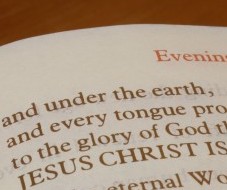
The tradition of the Assumption of Mary dates back to the very earliest days of the Church, all the way back to the days of the apostles. It was known that Mary had “fallen asleep” and that there is a “Tomb of Mary” close to Mount Zion, where the early Christian community had lived. The Council of Chalcedon in 451 tells us that, after Mary’s death, the apostles opened the tomb, finding it empty, and concluded that she had been taken bodily into heaven. The tradition was spoken about by the various fathers of the Church, and in the eighth century, St. John Damascene wrote, “Although the body was duly buried, it did not remain in the state of death, neither was it dissolved by decay. . . . You were transferred to your heavenly home, O Lady, Queen and Mother of God in truth.” The current celebration of Mary’s Assumption has taken place since 1950, when Pope Pius XII proclaimed the dogma of the Assumption of Mary in his encyclical, Munificentissimus Deus, saying: “The Immaculate Mother of God, the ever-virgin Mary, having completed the course of her earthly life, was assumed body and soul into heaven.” [1]
“My soul proclaims the greatness of the Lord;
my spirit rejoices in God my Savior
for he has looked with favor on his lowly servant.
From this day all generations will call me blessed:
the Almighty has done great things for me
and holy is his Name.”
This prayer of Mary from today’s Gospel reading is part of the Church’s daily evening prayer. Two incredible qualities of Mary come through in her prayer. The first is joy. She is one who not only allowed something incredibly unbelievable to be done in her, but allowed it with great joy. That she did this with joy tells us something very important about who she was. Teilhard de Chardin wrote, “Joy is the most infallible sign of the presence of God.” Those who live with joy, true joy, do so because God is at work in them and God is at work through them. Mary knew this from the moment the angel came to her. The second quality we see in Mary’s prayer is humility. She knew this wasn’t about her; this was about what God was doing in her and through her. It wasn’t she that did great things, no, “the Almighty has done great things for me,” she tells us, “and holy is his Name!”
Mary had very humble beginnings, as we all know. She wasn’t of a terribly well-to-do family, as far as we know, and she was a very young girl, probably around 14 years old. Yet even in that humble state, she was called to do great things, or, more precisely, to let great things be done in her. In much the same way, many of us may not feel like spiritual masters, or like we have great knowledge of our faith. But, we may very well be called to do things we think are too great for us. And that’s the truth, really. When God calls us to something, it’s almost always too great for us. But nothing is too great for our God, who can accomplish the redemption of the world with the cooperation of a humble 14-year-old girl. The Almighty did great things for Mary, and the Almighty will do great things for us as well.
Having given birth to our Savior, Mary is also the Mother of the Church. Her life is prophetic in the sense that it shows us what can and will happen to and for us who believe. In her Assumption, we see that God does not intend death to be the last word for any of us. Death no longer has power over us, because of the death and Resurrection of Christ. In Mary’s Assumption, we know that we are not destined for death and corruption, we are destined for life in the world to come, where death and sorrow and pain no longer rule over us. On that great day, death, the last enemy, will be completely destroyed, as St. Paul tells us today. On that great day, the great joy that Mary experienced in the Assumption can be our great joy too, for all of us who believe, and for all of us who allow the Almighty to do great things in them.
On that great day, we can join the loud voice in heaven and say,
[1] http://www.ewtn.com/library/ANSWERS/AOFMARY.HTM“Now have salvation and power come,
and the Kingdom of our God
and the authority of his Anointed One.”
